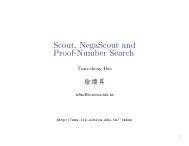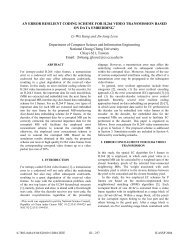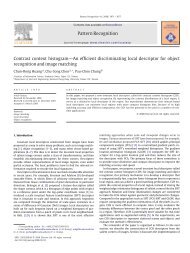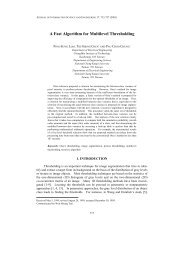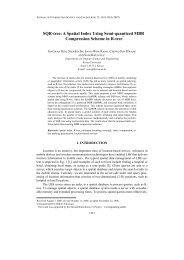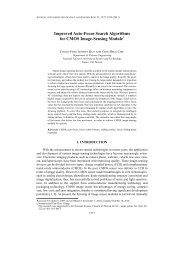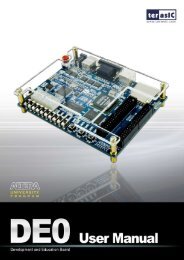Design, Implementation, and Performance Evaluation of Flash ...
Design, Implementation, and Performance Evaluation of Flash ...
Design, Implementation, and Performance Evaluation of Flash ...
Create successful ePaper yourself
Turn your PDF publications into a flip-book with our unique Google optimized e-Paper software.
FLASH MEMORY-BASED FILE SYSTEM ON CHIP<br />
original mpeg program outputs the decoded result onto a display device. To reduce the<br />
effect <strong>of</strong> the display, we removed the output part <strong>of</strong> the program.<br />
Fig. 13 shows the results with the three real-world applications. The x-axis in the<br />
graphs represents the host clock speed <strong>and</strong> the y-axis is the application execution time in<br />
milliseconds. Note that the scales in the graphs are different for each <strong>of</strong> the graphs. In the<br />
case <strong>of</strong> the I/O-bound cat, the conventional storage device shows better performance,<br />
while for the computation-bound mpeg, the FSOC performs better for all clock speeds.<br />
However, in the case <strong>of</strong> gzip, the performance <strong>of</strong> the conventional storage device <strong>and</strong> the<br />
FSOC crosses over when the host clock speed is at around 50MHz. These results validate<br />
the experiments done with the synthetic workloads presented above.<br />
5.3 Effects <strong>of</strong> Multiprogramming<br />
In this section, we compare the performance <strong>of</strong> FSOC <strong>and</strong> conventional storage<br />
when there are multiple applications running concurrently in the host system. To examine<br />
the effect <strong>of</strong> multiprogramming, we executed the I/O-bound application cat in parallel<br />
with an application that calculates the value <strong>of</strong> the circular constant pi, <strong>and</strong> measured<br />
the time elapsed to complete both applications. Fig. 14 shows the results <strong>of</strong> the experiment.<br />
Application execution time (ms) .<br />
4300<br />
3800<br />
3300<br />
2800<br />
2300<br />
1800<br />
1300<br />
800<br />
30 40 50 60 70 80 90<br />
Host clock speed (MHz)<br />
Fig. 14. Effect <strong>of</strong> multiprogramming.<br />
F S O C (c a t+ p i)<br />
C onv (cat+pi)<br />
F S O C (c a t)<br />
Conv (cat)<br />
F S O C (p i)<br />
Conv (pi)<br />
The application pi does not have any file operations, so the application run time is<br />
the same for both conventional storage <strong>and</strong> FSOC. Therefore, in Fig. 14, the results for<br />
FSOC (pi) <strong>and</strong> Conv (pi) are completely overlapped <strong>and</strong> look like one line. Cat is slower<br />
with FSOC as discussed previously when it is executed alone. However, when it is executed<br />
concurrently with pi, FSOC shows better performance. The implication is that<br />
when the host CPU is kept busy via multiprogramming, FSOC can perform better even<br />
for I/O-bound applications. This indicates that when there are more applications running<br />
concurrently on embedded systems, the performance benefit <strong>of</strong> FSOC will increase as<br />
well.<br />
1881



